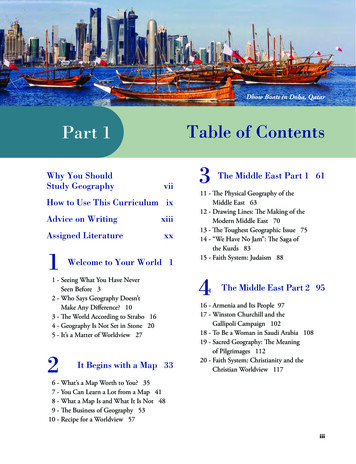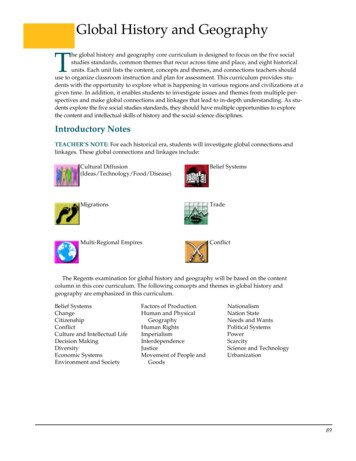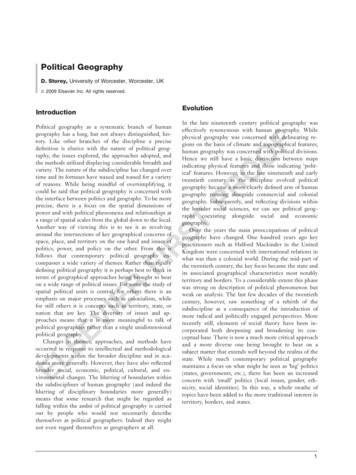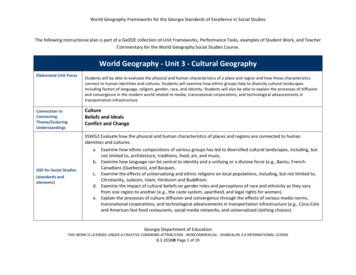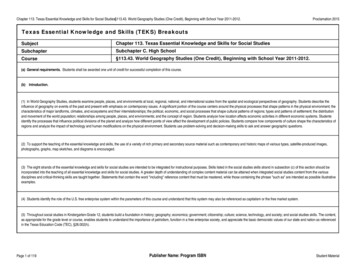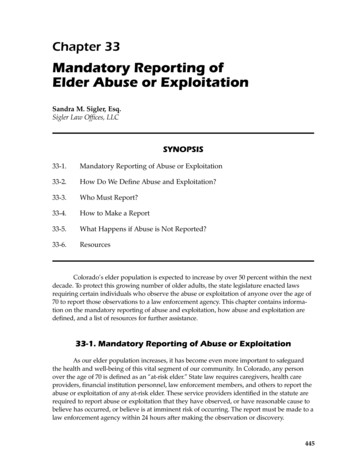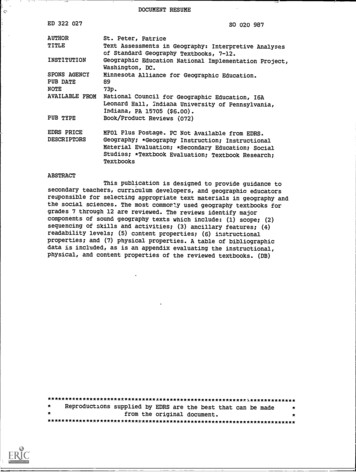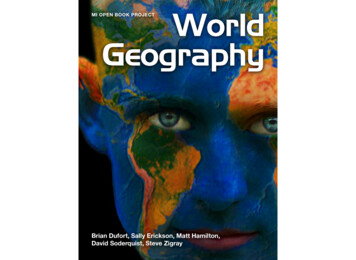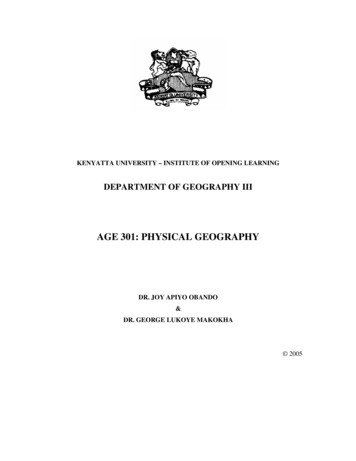
Transcription
Chapter 1Fundamental Concepts ofPolitical Geography:An IntroductionIntroductionThe simple answer to the question “what is political geography about?” iswhat it says it is about: politics and geography. But that is altogether toosimple. Political geography is by no means the sum of its two parts. In political geography, “geography” is drawn on in selective ways: in ways whichillumine the political. By the same token, “politics” is drawn on in ways whichshed light on the geographic. Above all, political geography focuses on thetwin ideas of territory and territoriality.Territory and territoriality are the defining concepts of political geographyin that they bring together the ideas of power and space: territories as spacesthat are defended, contested, claimed against the claims of others; in short,through territoriality. Territory and territoriality mutually presuppose oneanother. There can’t be one without the other. Territoriality is activity: theactivity of defending, controlling, excluding, including; territory is the areawhose content one seeks to control in these ways.1But again, that only takes us so far. To understand territory and territoriality as opposed to describing what they are about, we need understandings ofspace relations and politics. As geographic concepts territory and territoriality have their roots, their conditions, in other spatial practices; in particularthose relating to movement and those that have to do with the embedding ofpeople and their activities in particular places – ideas that are fundamental tocontemporary human geography. Likewise, in order to understand the political in political geography we need to come to terms with the central concept1 Consider in this regard the definitions given by The Dictionary of Human Geography (1986).Territory: “A general term used to describe areas of land or sea over which states and otherpolitical entities claim to exercise some form of control” (p. 483); territoriality: “The attemptby an individual or group to influence or establish control over a clearly demarcated territory”(p. 482).
2INTRODUCTIONof modern political science, the state. The state is itself an expression of territorial power: it has an area over which it claims jurisdiction, it has boundariesand it has powers to influence movement and what goes on in any part ofits jurisdiction. For any territorial strategy, any expression of territorialityadvanced by a neighborhood organization, a business or ethnic group, orwhatever, the state is, accordingly, of crucial significance.This begs the question, however, of what motivates people to defend particular areas and so to seek out the help of the state. It also begs the questionof why the state might be responsive. Territory itself has no substance andwhat motivate people are interests which are, by definition, substantive incharacter: they refer to things, perhaps symbols, that people want. In shortwe need some concept of what it is that drives people in their territorialactivities and what produces conflict over territory. Ultimately it has to dowith our relationship to the material world: our need to relate to that worldif we are to survive. But that relationship is always socially mediated. It isalways in and through others that we appropriate and transform aspects ofthat material world into forms which we can use. Concepts of social process,therefore, are central to understanding territory and territoriality. But specifically what social process are we talking about? In human history there hasbeen a succession of highly diverse social formations. This book, however, hasto do with the political geography of the specifically contemporary world.Accordingly our focus here has to be that highly dynamic force that we knowas capitalism.Now, this may sound as if the treatment is to be economically deterministic. This is far from my aim. Rather I recognize that social life is highly diverse;that it consists of many different conditions, without which it could not function. There is something that I will call the social process that is separate fromcapitalism. But capitalism is the energizing moment of that process and continually strives to mobilize those other conditions for its own purposes. Andin this it is no different from previous forms of social life. Production is alwaysthe central pivot around which social life is continually being organized andshaped.In the first major section of this opening chapter, therefore, the three principal ideas around which the argument in this book is organized are introduced: territory, the state, and the social process. The second part of thechapter is devoted to a consideration of some case studies through which Iwant to illustrate how these fundamental ideas can be applied. In a briefclosing section I will then outline how the book as a whole is organized.Fundamental ConceptsTerritoryThe core concepts of political geography can be stated quite simply: they areterritory and territoriality. These ideas are inextricably interrelated. Territoryis to be understood through its relations to those activities we define as terri-
FUNDAMENTAL CONCEPTS OF POLITICAL GEOGRAPHY3torial: the exercise of territoriality, in other words. Robert Sack (1983) hasdefined it as activity aimed at influencing the content of an area. This meansthat activities of an exclusionary or, alternatively, of an inclusionary naturewould be regarded as territorial and the area the content of which one wantsto influence as the territory in question. This means that in addition to territory having associations of area and boundary it also has ones of defense: territories are spaces which people defend by excluding some activities and byincluding those which will enhance more precisely what it is in the territorythat they want to defend.In these terms examples of territorial activity are legion. Import quotas andtariffs are obvious cases in point as are restrictions on immigration. Sometimesthe products whose movement is being regulated have a strong culturalcontent: the French government has tried to limit the amount of non-Frenchprogramming shown on French television. This is not to say that exclusionary processes are limited to the level of the nation state so that the territorythat political geographers focus on is that of the state’s jurisdiction. Examplescan be found at all manner of scales: the gated communities that have becomecommon in the suburbs of many American cities, for example; or the greenbelts which surround every British city of any size and which limit new residential development within their boundaries. And the latter example remindsus that any form of land use zoning is a territorial form of activity.There are also activities or processes of a more inclusionary nature. Peopleand organizations try to regulate the content of geographic areas by attracting in certain sorts of people or activity. The constitution of the state of Israelmandates that all Jews should be accorded full rights of residency in Israel ifthey should request it. A different sort of example has to do with the channeling of investment flows. For many years in the United States local andState2 governments have implemented a variety of policies the goal of whichhas been to attract new investment inside their boundaries: investment thatwill, among other things, generate employment and add to the local tax base.This sort of activity is now becoming more common in Western Europe. Themember states of the European Union have been especially active in competing for choice investments like those of the Japanese auto companies.This is not to say that exclusionary and inclusionary forms of policy areunrelated. What is inclusionary for some may be exclusionary for others,and that may be the point of the exercise. Gentrification has been a commonhousing market process in neighborhoods close to the downtowns of majorcities in both North America and Western Europe. As wealthier people moveinto an area so rents and housing prices tend to increase. This results in theexclusion of long-term, low-income residents who can no longer afford therents. But this is a process the gentrifiers promote through trying to securefor the area various local government expenditures and regulatory policiesthat will make the area more attractive to the well heeled buyer. And oneof the purposes of that is, through the medium of increasing real estate2 Throughout this book I use State with a capital “S” to indicate US (and Mexican) States, andstate with a lower case “s” to indicate the state as a universal concept.
4INTRODUCTIONvalues, to drive out the poor, who for various reasons are regarded as lowering the tone of the area, perhaps introducing a criminal element into theneighborhood.The idea of territoriality is derivative of other concepts absolutely crucialto contemporary human geography. These are the related ones of mobilityand immobility. Geography, bear in mind, is the study of objects, activities,institutions from the standpoint of their space relations (both internal andexternal), what we might call their various where-nesses. These include theiraccessibility relations with respect to one another, and their distributions.One way of studying human geography is in terms of movements. This wasa dominant theme in the spatial analysis school which dominated humangeography for much of the sixties and which is still influential today. Thepoint is that the reproduction of a particular distribution of objects – factories,houses, highways, airports, the people themselves – depends on various sortsof flow: movements of raw materials for the factories, movements of moneywith which to buy the raw materials, movements of labor among others. Tothe extent that the geography of movement changes then so will the distribution of houses, factories, and the like. As investment moves out to thesuburbs, for example, so the form of the city changes: housing is added on theedge but we often find housing towards the center of the city being deleted.The shift of investment to the suburbs is a major reason for the fact of housingabandonment that is so apparent in some American central cities, like Detroitand Chicago.But more recently, the converse of movement, the idea of settlement, ofimmobilization or embedding in a particular place, has come to be recognizedas of immense significance. This is particularly so from the standpoint ofunderstanding territoriality. It is certainly true that people move around. Residential mobility within cities is a fact of life and without it realtors would goout of business. And people also move over much longer distances, retiringfrom, say, New York or Montreal to Florida or from the United Kingdom tothe Costa Blanca in Spain. In similar fashion firms move. They close or sellfactories in one location and shift their operations elsewhere. But there arecontrary tendencies as well. People, firms, organizations of all types getembedded in particular places: embedded in the sense that other placesbecome costly substitutes for their current locations. People put down whatare often referred to as “roots.” They buy houses in neighborhoods, and raisefamilies. Their children marry and some, at least, will live in the same city.People also get locked into particular careers with particular firms: theydevelop skills which are appropriate to their particular employer but whichhave limited portability. So leaving the area, moving elsewhere, can mean aserious diminution of life chances, a deep sense of loss as one moves awayfrom one’s loved ones and the familiar, or both. Even owning a house is asource of geographic inertia since buying and selling is such a protracted andtime-consuming process.In similar fashion firms develop collaborative relations with other firmsin the same locality and these can be a source of competitive advantage.
FUNDAMENTAL CONCEPTS OF POLITICAL GEOGRAPHY5Firms may share the same labor supply. A virtue of being located next to otherfirms manufacturing similar products is that when one of them is releasingworkers another is likely to be hiring. So labor shortage is unlikely to be aproblem in the area whereas moving to a city where the firm is the only onethat has those sorts of skill demands is. In short, firms can get locked intoareas not just through the productive relations they enter into with other firmsbut also through the way they may share with those firms labor reserves orsuppliers.3This means that people, firms, organizations may be very dependent onwhat happens in the area they happen to be located in. People buy houses inneighborhoods and see the house, to some degree at least, as an investment:an asset like stocks or bonds or a savings account on each of which they expecta return. In the case of investment in the house you live in the return is in theform of an increase in its value. But neighborhoods can change as some peopleleave and others move in, as undeveloped land is rezoned for gas stations orbars. In short, movements in and out can threaten investments in homes.Money has been invested in something which is difficult to move, which isliterally embedded in the ground. If values are to be maintained let aloneincrease, territorial strategies have to be deployed: attempts to structuremovements into the area by (e.g.) opposing the rezonings that will allow gasstations or bars or the conversion of existing owner-occupied housing intoapartments.As we have seen, firms likewise get immobilized, dependent on particularlocalities or those in them, and the continual flow of value through them. Butthe arrival of new firms in the area can threaten that flow of value andhence their profitability. The increased demand for labor that comes about canresult in increased wage levels, particularly if the new arrivals are the branchplants of unionized firms. To the extent that labor shortages are moderated byin-migration then pressure may be transferred to the housing market, and ashousing prices increase this too can exercise upward pressure on wages. Yetrelocation by the firms so affected to areas where lower wages prevailwill be difficult. It may be hard to persuade the workers on whose skillsthe firms depend to move with them, and training new workers will bea protracted and costly process. And it will certainly be hard to reconstitute elsewhere the collaborative relations with other firms so important tocompetitiveness.As a result they can be expected to organize to defend their territoryand the advantages it provides them. They may, for example, pressurecity government to ease bottlenecks in housing supply so that the upwardshift in housing prices can be contained: facilitate the speedier rezoning of3 Firms may have specialized transport or marketing needs. If located alongside firms producing similar sorts of product demand may be such that these activities can be subcontractedto specialized suppliers able to operate at lower cost. Whereas if the firm is only one in the areawith those particular needs it may have to (e.g.) purchase its own trucks, even though it maynot need them on a continual basis.
6INTRODUCTIONland to higher densities, eliminate delays in servicing raw land with waterand sewerage. And the policies that are bringing new firms into the area willalso come under review: should city government be so aggressively courtingfirms to locate their branch plants there, for instance?We will see in what ensues that territory and territoriality can assume morecomplex forms: that what is a territorial strategy for some is a threat to theterritorial strategies of others. But the relation between mobility and immobility, of movement and embeddedness, is central to the emergence of territory as an issue: to the desire to influence the content of an area. And as wehave seen from the examples above, territorial strategies typically draw insome way on the power of the state: its power over rezonings, over local economic development policy, for example. It is therefore entirely appropriatethat the state should be our next focus of concern.The stateFor a start, notice how important the state and its various agencies are in regulating geographies: in structuring movements, in defending the interests ofthe more immobilized, the more embedded. Central governments everywhereregulate movements across their boundaries: movements of people, of commodities and of money. They may restrict imports in order to protect particular industries, their workers and the cities in which they are located fromforeign competition. They may also restrict exports for a similar purpose: aduty on exports of American leather protects the shoe making industry bydriving up its price to overseas producers at the same time as it lowers it forthe American producer. Limits on immigration on the part of the more developed countries4 are the norm and so too is the regulation of foreign investment. In the latter regard there are often laws governing the takeover of firmsby foreign corporations or foreign investment in certain sensitive industrieslike arms firms.Likewise there are things that local government can do that impact ongeographic change through their effects on movement. This is despite the factthat central branches of the state protect the freedom of movement of labor4 Use of the term “more developed countries” raises an important issue for this text. Theproblem is one of differentiating between countries but not in a way that implies value judgments. The “First World/Third World” distinction clearly implies hierarchy and will not be used.Alternatives to “more developed”/”less developed” are “rich”/”poor” and “North”/”South”.I am deterred from using the latter by virtue of its transparent inaccuracy. There are more developed countries in the South, like Australia and New Zealand, and less developed countriesin the North, like Egypt or Pakistan. The “rich country”/”poor country” distinction seems noimprovement on the “more developed”/”less developed” distinction since to define someoneor someplace as poor is often (not always) to imply some sort of lack on their or its part. At leastthe term “less developed” implies a process of change towards the more developed pole. Thatgets us into the problem of whether development is a good or a bad thing but it neverthelesssoftens the sense of invidious distinction between countries. It is, therefore, the term that I willuse in the remainder of this book.
FUNDAMENTAL CONCEPTS OF POLITICAL GEOGRAPHY7and of commodities within national boundaries and so local governmentscannot try to achieve their ends by interfering with them: protecting a majorlocal employer by imposing restrictions on the sale of goods from competingfirms elsewhere in the country, say. Rather there are other means of structuring location choice. Urban development, the siting of new housing developments, new industrial estates, and the location of new highways mustinvariably run the gauntlet of a local permitting process: public hearings,rezoning hearings, objections from national public health authorities, andso on.Nevertheless, the relation between the state on the one hand, and power insociety on the other, including power over geography, is not straightforward.Power comes in different forms. Immensely important in contemporary sociallife is the power of money. This is not something which is foreign to the state.This is because it itself draws on that power in persuading others to do whatit wants: tax concessions, subsidies, various forms of duty, the threat of fines.But it is also a power that anyone participating in a market, or for that mattertrying to purchase the favors of a legislator, draws on. The power of moneyis expressed among other things in what urban analysts call the competitivebidding process. The wealthy, by and large, live in the more desirable neighborhoods because they can afford to: they have the money to outbid otherwould-be purchasers.Likewise there is the power of the normative. Norms are important in regulating family life and much else besides. It isn’t just the power of money thatmakes us punctual for work; the fear that we will be fired if we don’t turn upon time. We have been socialized into it from early childhood on: “do not belate for meals,” “do not be late for school,” “hurry, or you’ll miss the bus.”Again, this is something that the state can turn to its own advantage. It is aform of power that it employs through the schools. It is through the educational system, both state schools and the private schools – that are always regulated by the state – that certain rules of good citizenship are imparted. Andthrough its public statements, if not always through its actions, it advocatesthe ideal of equality as a principle of social justice.Yet in talking about the state and its relation to various forms ofsocial power we need to bear in mind that the state form is not a universal.There have been societies which lacked states. Some of these exist at thepresent time in, among other places, the jungles of Amazonia or Borneo. Andin many other so-called states, particularly in less developed countries, thepower of the state, its ability to penetrate and regulate social life, is weakindeed.But having said that, a case can be made for some sort of regulation in allsocieties. Government with the intent of harmonizing the activities of different people one with another has been an omnipresent feature of all social life:the household, kinship, and the various norms accompanying them, forexample. And indeed today these regulatory mechanisms continue to play arole alongside more historically recent ones like the market. But what is characteristic of the present era is the role of the state as, in effect, the regulator ofregulators: as the ultimate guarantor – and limiter – through the law, of the
8INTRODUCTIONsocial power of others, whether that of capitalists, husbands, and parents, orthat of money in the abstract. In other words, there can be government withoutstates; but states always entail government.Territorial strategies are always exercises of power. To some degree theymay depend on the direct exercise of state power: redrawing the catchment districts of schools so as to simultaneously include some andexclude others; or assigning additional police patrols to a neighborhood.Sometimes, on the other hand, strategies appear to be more private incharacter. This would apply to the gated community or the private school,both of which can have exclusionary intent. But ultimately they both dependon the state. Gated communities have to be legal, as do private schools. Andeven if private schools are legal the state can take steps to make themmore or perhaps less attractive as territorializing options through the sorts oftax concessions it makes to parents (i.e. whether or not school fees are taxdeductible).But what is attractive about the state as a means of regulating space relations, as a vehicle for the various exclusionary and inclusionary policies different organizations, firms, political parties, residents’ organizations push for,is its own territorial character. Consider the variety of possibilities here.Imagine, for example, a state whose power was not territorial in the sense ofareal and bounded. What if (e.g.) people who were the citizens of differentstates were not as they are now, geographically segregated one from another,but geographically integrated? Imagine a situation, in other words, in whichyour next door neighbors, other people living in the same city or region asyou belonged not to the same state but to different states: that American citizens lived in the same neighborhood alongside French, German, British,Mexican, Australian, Nigerian citizens and they were all subject to the laws oftheir respective countries.While on the one hand this might have its advantages – it would makewarfare a very difficult enterprise, for example, since “friendly fire” victimswould be at least as numerous as enemy dead – it would also make the implementation of other, less lethal, territorial strategies highly problematic.An interest in remedying something like acid rain in response to the demandsof people downwind of factories and power stations with high sulfur emissions would be extremely difficult to bring about. This is because it wouldinvolve so many independent sovereign powers in multiple, many sided,negotiations with one another: a high level of geographic fragmentation ofpower where what is needed to remedy the situation is a spatial centralization of power. In other words, what is required is states that respectively enjoyuninterrupted sovereign power over large, continuous areas that in termsof their shape are relatively compact: neither punctured, highly elongated,fragmented, nor indented (figure 1.1). And of course it is precisely towardsthe latter compact form that states in their jurisdictional geography tend.This is what makes them so appealing to those promoting territorial strategies of various sorts: it promises some sort of resolution of conflicts, thoughnot necessarily in favor of them or their particular territorial projects asopposed to those of others.
FUNDAMENTAL CONCEPTS OF POLITICAL tionFigure 1.1 Deviations from compactness along four dimensions. Consider the compactness or otherwise of state forms and those jurisdictional subdivisions like theCanadian provinces, British counties, French départements and US states in terms ofthese different dimensions.Source: P. J. Taylor (1971) “Distances within Shapes: An Introduction to a Family of FiniteFrequency Distributions.” Geografiska Annaler, 53B(1), 43. Swedish Society for Anthropologyand Geography.Think and LearnIn talking about the compactness of state jurisdictions I used the term “tend.”Think of exceptions to the compactness rule. What states are elongated,punctured, indented, or fragmented? How would you judge the US or Canadain these regards? Peruse a world atlas in order to identify these deviations.Significantly, the territorial principle is writ large in the geographic structures of states. The internal organization of the state includes a division intolocal and central branches and sometimes branches at a more intermediatelevel (regional or provincial governments, for instance) and these all tend tothe same compact form, as a scrutiny of the geometry of the States of the US,the counties of the United Kingdom or the départements of France wouldquickly confirm. The territorial principle likewise extends to representationand to many state policies. The constituencies or Congressional districts thatlegislators represent are discrete, bounded, relatively compact areas. Compactness is viewed as a virtue to the extent that any serious departure from itis likely to be viewed with suspicion: as signifying, that is, some attempt tomanipulate boundaries in order to guarantee a particular electoral outcome.55So-called “gerrymandering”.
10INTRODUCTIONWithin state jurisdictions there are yet other partitions that relate not to representation but to actual policies: the land use zones of local governments; theSpecial Areas of the United Kingdom designated for assistance in attractingnew employment; conservation areas, historical districts, urban renewal districts, Areas of Outstanding Natural Beauty, etc.None of this is accidental. One can say that it is this which makes the stateso important to those with territorial interests. But it also reflects the significance of territoriality as an organizing principle of social life. People have territorial interests that they share with at least some people in the same area andwhich bring them into competition and conflict with those elsewhere. If theseinterests are to be expressed then it makes sense to organize elections throughterritorially defined voting districts.6 And if they are to be satisfied, then somepolicies at least should be territorially differentiating.So it is important that the state’s organization be through and through territorial: that there be local as well as central branches; that legislators represent geographically discrete districts; and that there be, for some policies atleast, ways of making their incidence geographically differentiated in someway. This is a state in short that is appropriate to the expression and realization of interests of a territorial nature.But a territorial form that facilitates the expression and realization of oneterritorial interest may be less satisfactory from the standpoint of others. Justas state policy is a stake, therefore, as people, firms, labor organizations, andso on struggle for policy outcomes enhancing to their neighborhoods, regions,industrial districts, and countries, so too is the structure of the state itself. Wewill see later that a major issue dividing people, firms, and other organizations has been the internal organization of the state in its territorial aspects:the degree to which, that is, the state should be a highly centralized one, onewhich reserves few powers and responsibilities for more local branches, asopposed to one that decentralizes a good deal of its power to more local orregional levels. Recently this has come to the fore in the UK with the implementation of some devolution of power to Scotland, Wales, and NorthernIreland. It is also of ongoing significance in debate about the future form ofthe European Union. But it is not just the territorial organization of the statethat is contested. Modes of representation, how territorial they should be, haveoften surged to the fore as an issue. In the US Senate each State has two Senators regardless of population; so representation is by State rather than proportional to State population. But in Canada there is no such equality betweenthe provinces. Not surprisingly, perhaps, the less p
closing section I will then outline how the book as a whole is organized. Fundamental Concepts Territory The core concepts of political geography can be stated quite simply: they are territory and territoriality. These ideas are inextricably interrelated. Territory is to be understood through its relations to those activities we define as terri-
